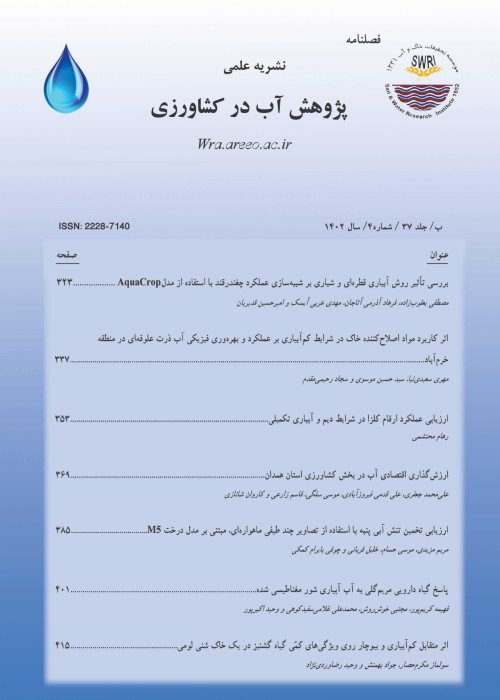Evaluation of Irrigation Management and the Possibility of Improving It in Wheat Fields in Sistan Dam Irrigation District Using SWAP Model
In this research, the status of water productivity for wheat production and strategies to increase water productivity in different quantitative conditions of water was determined and analyzed in the irrigation district of Sistan Dam. In this regard, the SWAP simulation model was calibrated and validated by considering the current water resources operation, various quantities of irrigation water, and use of field information. Water production functions were used to determine the irrigation schedule (time and depth) for wheat crop. The results of field measurements in the crop year 2016-2017 in the irrigation district showed that farmers irrigate wheat on average four times in the current conditions. Farmers' average crop yield and water productivity were about 1450 kg/ha and 0.41 kg/m3, respectively. These results show that available water is not appropriately used and should be addressed with practical solutions to improve water productivity. The validation and calibration results of the SWAP model also showed the high accuracy of the model in the case study. The results of different management scenarios of eliminating some irrigation shifts compared to the existing conditions indicated that, although there was no significant difference in water productivity, crop yield decreases about 37%. The results of evaluating the scenarios of reducing the depth and frequency of irrigation (using 640 mm per season and applying 40 mm at each shift) showed that, with reliable and timely water supply and more frequent irrigation, water productivity could be increased by 30% compared to the baseline scenario; and crop yield can be doubled. In these scenarios, the presence of adequate moisture in the plant's root zone increases the yield, and the amount of deep percolation is greatly reduced. The amount of water used by farmers is excessive for various reasons. Therefore, it is recommended to train farmers on how to improve irrigation and crop management according to the water available in the irrigation district, so that they can distribute water according to the real needs of the plant and irrigate at the right time and sufficient quantity.
- حق عضویت دریافتی صرف حمایت از نشریات عضو و نگهداری، تکمیل و توسعه مگیران میشود.
- پرداخت حق اشتراک و دانلود مقالات اجازه بازنشر آن در سایر رسانههای چاپی و دیجیتال را به کاربر نمیدهد.


